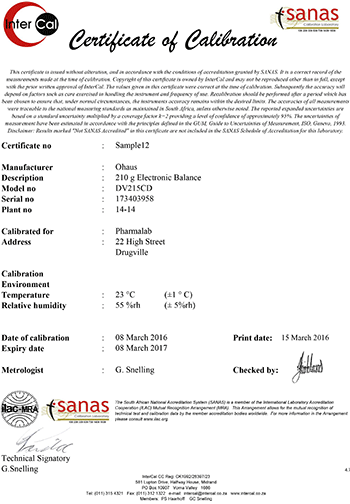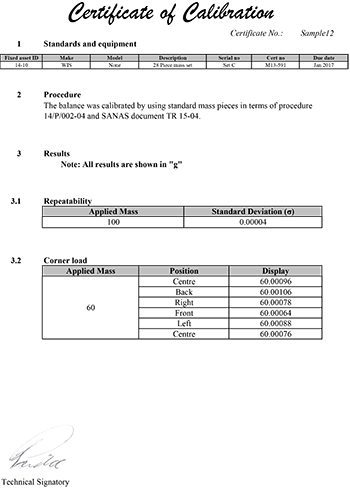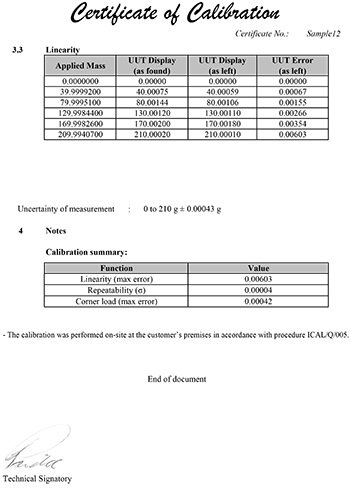
Many people see calibration as a service that costs a lot and gives little in return, but if understood and used properly, a calibration certificate is a tool that can be used to give confidence to measurements; to understand measurements that are made; and ultimately is an investment that adds value to the equipment far and above the cost of the calibration.
This paper will guide those users of calibration certificates through the myriad of text, tables and terms to reveal the useful data and to uncover the true value of a calibration certificate.
ISO17025 and calibration certificates
What, who, when, where and how?
Taking a look at the standard ISO17025, to which all internationally recognised calibration laboratories comply and are accredited, we find that there is much information that must be included on a calibration certificate issued by one of these accredited laboratories.
The first page is designed to show the customer details about what was calibrated, when and under what conditions. Some of the requirements of ISO17025 are obvious: these include the title ‘Calibration Certificate’, name and address of the laboratory, name and location of the customer, name of authorising signatory, date the calibration took place, the environmental conditions at the time, unique identification of the item calibrated and the unique identification number of the certificate.

On the second page is a section that covers the ISO requirement for evidence of traceability to national measuring standards. Sometimes this can simply take the form of a statement, but in other cases there is a list of equipment that was used to perform the calibration, including calibration certificate numbers and calibration due dates.

The section is then followed by the identification of the procedure used to perform the calibration. These procedures can often run to several pages so are here referred to by procedure number. A lot of work goes into writing a complete and thorough procedure; so many laboratories are hesitant about releasing them to clients. But rest assured that the calibration procedures used in SANAS calibration laboratories are monitored by SANAS during initial and annual assessments.
And what did we find?
The next section of the certificate covers the results of the calibration. Due to the many types of instrumentation that are calibrated by laboratories, the layout and actual results taken will vary from certificate to certificate. However, there are some basic fundamentals that should be observed.

In accordance with ISO17025, the results must be accurate, clear unambiguous, objective and in accordance with the method or procedure used. If available, calibration results obtained before and after adjustment and or repair must be included. We’ll find out why this is important, a little later.
Measurement uncertainties must also be included, as well as an indication with compliance with a standard or specification, if applicable. Again, we will cover uncertainties of measurement a little later.
The certificate may also include results obtained from a sub-contractor, and these results must be clearly marked as such.
ISO 17025 also allows for amendments and supplements to calibration certificates as well as opinions and interpretations where necessary. The requirements for these would be dealt with on a case-by-case basis and so familiarity with ISO17025 is advised.
And all this is useful how?
So we have our calibration certificate and we now have a bit more of an idea of what it all means. But what do we do with it?
Well there are several reasons for having an instrument calibrated in the first place, so let’s deal with them one at a time.
Traceability
The measurements that you make with your instruments are most useful if they can be related to other, similar measurements. Thus the mass of a sample measured in one country should give the same mass when measured in another country. This helps companies to maintain manufacturing tolerances throughout the world so that end users can have confidence in the products that they buy. This is easily achieved when the measuring instruments in each country have both been calibrated using standards that are traceable to each other.
Calibration certificates must therefore indicate this traceability, either by listing the standards used in the calibration or by a statement to the affect that the measurements are traceable. In any case, records of standards used are kept by the calibration laboratory for inspection.
Uncertainty
In an ideal world, the measured mass of a sample measured in one country would be exactly the same as the measured mass of the same sample measured in another country.
Unfortunately there are many factors that can affect a measurement and therefore the two measurements will differ by a certain amount. The factors influencing the measurements are evaluated and an “uncertainty of measurement” is determined. Taking this uncertainty into account helps us to make decisions about the accuracy of our measurements and therefore, for example, the acceptance or rejection of a sample based on its specification.
One of the factors used in determining the uncertainty of the measurements is the uncertainty of measurement quoted on the calibration certificate. This should be used in your own calculations for the uncertainty of measurements you make with the instrument.
Another value to be used is the reference made to the “confidence level” that was quoted on the first page of our example certificate. This is used in the statistical calculations of the uncertainty of measurement.
Reliability
When using an instrument you need to know that the readings can be trusted. Again, in an ideal world every instrument would read perfectly every time. Unfortunately the state of affairs is not so easy and readings on an instrument will vary even when measuring the same sample, and this variance with change over time. The degree of this variance should always be within the specification of the instrument since the specification is the basis on which the instrument was initially purchased, otherwise corrections must be made.
The results on the calibration certificate will indicate the degree of accuracy of the instrument, but only at the time and conditions of the calibration. The tendency of these results to drift can only be determined by historical data and thus the necessity for regular calibration. Previous calibration results can be graphed against more recent ones and the drift can then be determined and extrapolated (with care) to determine the current accuracy of an instrument.
Accuracy
Of course the most important question to be asked is “How accurate are my measurements?” This can be determined by analysing the results on the calibration certificate.
Again, the actual results given on the certificate may vary both in specific values and also in formats, but generally the value of a standard is shown and the result obtained when using the 2006 Test and Measurement Conference instrument to measure that standard is given. (Obviously this applies to measuring instruments. Certificates for instruments that source a value will give the nominal value of the instrument, along with the value measured by the standard measuring instrument.)
The actual error of the instrument may then have been calculated and shown or a correction value is given. (‘Correction’ is the algebraic opposite of ‘error’ and by convention corrections are algebraically added to results.)
At some point however, it may be tiresome to correct large errors of an instrument and the instrument will need to be adjusted. It is critical to maintaining a valid history that calibration values are determined before adjustments are made, and then those same values are measured again after the adjustments. These are often listed on certificates as ‘pre cal’ and ‘post cal’ values or sometimes ‘As found’ and ‘As left’ values. However they are named, the use of these values can allow the continued determination of the drift to be maintained.
What about re-calibration?
Even though an instrument may have been supplied with a calibration certificate from the manufacturer, as we have seen previously, unless this certificate indicates its traceability, then it’s not worth very much. It is therefore important to have new equipment suitably calibrated at the time of purchase before putting them into use. This calibration will also form part of the commissioning of an instrument, and also gives useful evidence in a case for a warranty claim if an instrument is found to be out of specification.
But how often should an instrument be recalibrated? The ISO standard 17025 puts this decision into the hands of the user. Generally speaking though, recalibration should be performed when you no longer have confidence in the measurements made by the instruments, or can no longer prove traceability of the measurements.
Factors that may be used to determine the re-calibration period, or calibration cycle, would be the amount of use, the way it is handled, and the degree of required accuracy. Regular validation measurements can be used to monitor the drift of an instrument and to then determine its current accuracy. Using statistical analysis of calibration results and also of validation measurements, expected calibration intervals can be chosen and either shortened or extended as required. It is therefore important that records be maintained of calibration, validation and maintenance work, and it may also be useful to restrict the use of the instrument only to suitably qualified persons.
Conclusions
And so we come to the end of our journey through the calibration certificate.
We have seen why calibration certificates are issued; what information appears on the certificate and why; how to use the results data to show the accuracy of your instrument; how to use the certificate to maintain calibration history and to determine drift; and how to determine calibration cycles.
All of this information, if used correctly, adds value to your instrument; not only in the value obtained from being able to trust measurements taken by the instrument, but also an increase in the value of the instrument itself. Should you choose to sell the instrument at some point, the inclusion of a comprehensive calibration history file into the sale may actually increase the sell price past the initial purchase price.
So the next time you balk at the prospect of spending money on calibration, rather think of it in terms of investment rather than expense.
For more information contact InterCal, +27 (0)11 315 4321, [email protected], www.intercal.co.za
| Tel: | +27 11 315 4321 |
| Email: | [email protected] |
| www: | www.intercal.co.za |
| Articles: | More information and articles about Intercal |

© Technews Publishing (Pty) Ltd | All Rights Reserved